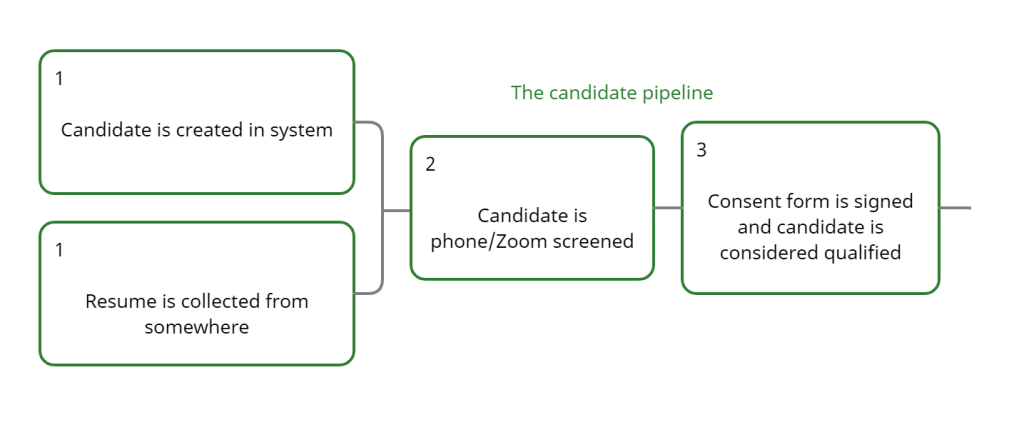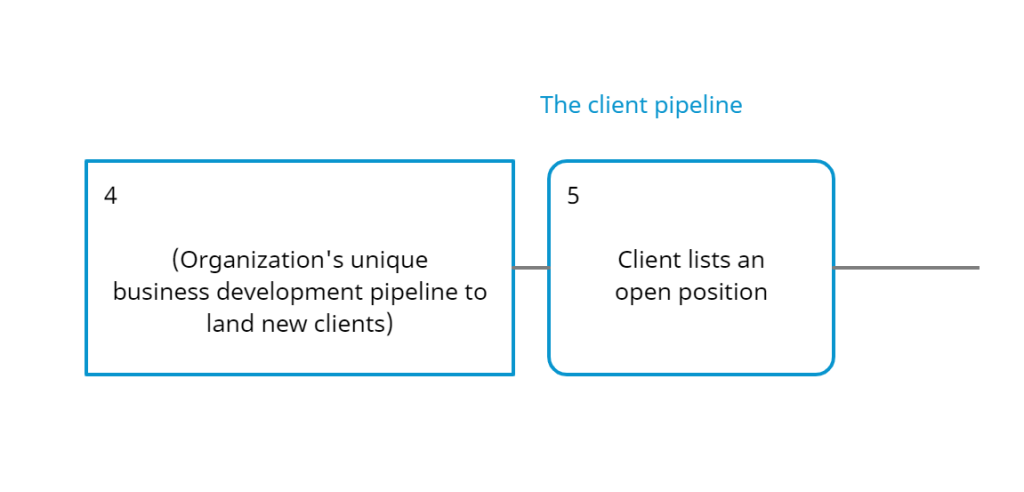
Recruiting is all about finding qualified people to match open positions. At its essence, the job of a recruiter is to serve as a matchmaker between job-seekers and hirers, to balance two ever-changing pipelines and make some type of lightning strike between them.
This proverbial lightning strike is the act of a candidate being hired, and it requires timing, patience, organization, and lots and lots of skill. The candidate pipeline is perpetually updated with new applicants with a diverse array of skills. The client pipeline, which supplies open positions, is also constantly rotating with different skill requirements, salary ranges, and so on.

It’s tough to get it right, which is why Customer Relationship Management tools (CRM) and Applicant Tracking Systems (ATS) exist, and why they keep getting better and better.

Recruiters use a ton of different tools to keep track of their various pipelines. One of the biggest ones, however, is CRMs. As a functional SQL database designed for keeping track of many moving parts and data points, CRMs have enough versatility to be a good one-size-fits-all solution for recruitment as a whole.
In order to have a steady stream of open positions, clients need to be communicated with regularly. CRMs are the perfect tool for client relation management, with a range of communication and tracking capabilities, organized pipelines, workflows, automations, and more, that render CRMs instrumental in managing the client pipeline.
CRMs also help recruiters save time is by automating tasks. Most CRMs have personal email sequences that allow recruiters to automatically send a series of emails with standardized messaging, which is great for new candidates, soliciting open positions from clients, and much more.
Tracking applicants’ journeys through the recruiting pipeline is also critical to recruiting as a whole, and CRMs do this phenomenally. A lot of CRMs, like Nutshell (just sayin’), provide a range of stellar reports that can be used to analyze and optimize pipelines and processes in the recruiting space and beyond.

Although it’s not abundantly clear, recruiting processes and sales processes are similar enough that a CRM, often perceived as software for salespeople, can satisfy the needs of both industries. CRMs typically have a bunch of functionality specifically designed to serve a diverse array of industries. Some cost a ton, others don’t.
CRMs with forms, for instance, are a wonderful resource for reposting jobs (directly on your website, which is cool), as well as collecting information directly from candidates. Forms basically eliminate the need to solicit repetitive information via emails and phone calls, which opens up a lot of recruiting possibilities.
Recruiters also take advantage of CRMs’ automation capabilities by automating as many communications as possible.
There are tons and tons of standardized messages that need to be sent in the recruiting biz. Resumes, contracts, consent for submission to open positions, retainers, etc., all of which can be automated within a CRM to trigger at specific points in the recruiting pipeline.
And CRM reporting features are instrumental as well. It’s always crucial to inspect any pipeline from the top down, and CRMs make this a piece of cake. From looking at reports regularly, recruiters can see which parts of their candidate pipelines and client pipelines aren’t functioning as they should.
Reporting also helps identify which clients are good clients, which recruiters are filling positions, and any trends that may arise within a specific recruiting organization’s pipelines.
Essentially CRMs serve to manage the two recruiting pipelines:
The first recruiting pipeline serves to manage the ever-changing talent pool. The talent pool is the current accessible market of candidates, and keeping track of every single one is no easy feat.
Fortunately, software like ATS systems and CRMs both solve for this by allowing recruiters to make a new entry in the database for each person, and document their associated data (skills, requirements, education, location, preferences, etc.) on their profile in the system.
CRMs also allow recruiters to attach candidates’ resumes directly to their profiles as well. Having the resume accessible on-hand is great for doing candidate phone calls, communications, and also for attaching the resume to emails to submit to clients.
The various ways of viewing data in CRMs are also useful, for instance, a skill (or any data point) is something that can be searched directly within the system, making it easy to parse big lists of candidates with a diverse set of data points.
For instance, if trying to find a candidate with SQL skills, a recruiter might start the search by typing SQL into the CRM search bar and exporting the results.
At the end of the day, this pipeline serves to manage all of the candidates that a recruiter might want to submit to a client. If it’s not doing what it’s supposed to be doing, it doesn’t matter how many open positions there are, there will be no applicants to match them with.
The second pipeline is the business development pipeline. It is often referred to as the client pipeline, which implicitly highlights the contrast against the candidate pipeline.
This pipeline literally serves the function of new business development, which is a standard practice performed by business development representatives in any industry. Sometimes the goal is to secure investors, sell a product, or score a work contract.
In this case, the goal is to garner open positions that can be staffed with applicants from your recruiters, who become employees at the client’s company. If this pipeline isn’t functional and the open positions stop flowing, all the applicants in the world can’t help, which is why it’s important to keep both pipelines healthy.
The client pipeline is almost always serviced by a quality CRM, which helps BDRs and recruiters keep track of open positions, client communications, and all of the clients’ needs in one place.
Furthermore, since this is often a collaborative process, CRMs with team collaboration tools built-in are instrumental in preventing wires from getting crossed, communications from being duplicated, or any members of the business development team being left in the dark on the status of a lead or deal.
A final important point on the client pipeline is that it absolutely needs to remain up-to-date at all times in order to approach clients and candidates alike with the most relevant information.
Technically speaking, an applicant tracking system is quite similar to a CRM. They’re almost entirely the same software—a SQL database at its core with a neat UI—but branded differently and fitted with industry-specific functionalities. CRMs typically lean in the sales direction, and ATS systems lean in the recruiting direction.
ATS systems and CRMs both serve as a repository for candidates and their pertinent information. They both allow each person their own “page” where all of their skills, employment history, and current information is viewable like a hub. Furthermore, both systems allow for attachments to be uploaded such as resumes and employment documents.
Another critical feature that both systems offer is the ability to search the system quickly with keywords, making finding applicable candidates an effortless experience.

The most commonly used feature that both systems possess is the ability to keep notes on each candidate throughout the recruiting process. Notes can be for feedback, reminders, or anything pertinent to the candidate (or client), and are viewable in real-time by all members of the team.
CRMs and ATS systems have a lot in common but there are a few key differences, including:
Design and embed simple web forms, track their effectiveness, and quickly reach out to form-fillers, all out of Nutshell.


Most companies use an ATS in conjunction with a CRM. Some just use an ATS, and some just use a CRM. For the following section, we’ll be focusing specifically on how to use a CRM to maximize efficiency at each stage of the recruiting process.

The candidate pipeline is the path that candidates take before they are ready to be submitted to clients. There are several stages involved in qualifying and preparing a candidate for submission:
This step varies from company to company, but a typical model for this recruiting step involves a resume being imported into the CRM from Dice, Monster, Linkedin, Indeed, or any other employment platform.
Occasionally, candidates will submit their resumes directly to the recruiting team, but they’ll still be created in the CRM as a person with their resume as an attachment, just like normal.
The phone screen is usually just to get to know the candidate and set some goals from the start. Typical questions for a phone screen include:
All of the takeaways from the phone screening conversation are subsequently saved in the CRM as a note so that any member of the team can view it and make comments.
This step is quick, but it serves a pivotal moment in the recruitment process, so it gets its own step. Candidates that have not signed a consent form cannot be submitted to open positions otherwise issues can arise down the line—like the candidate outright bailing after being offered a job, which looks bad for everyone.
The signing of the consent form is captured in the CRM by attributing the candidate to this pipeline stage, and attaching the consent form to their person hub in the CRM as an assurance so that nothing slips through the cracks.
The candidate is now ready to be submitted to clients. 🎉

The client pipeline is where the business development team focuses its efforts in order to keep the open positions flowing.
As with most other business development processes, this one more intuitively matches CRM functions, despite both pipelines being fully manageable from a solid CRM. The client pipeline is as follows:
This step isn’t worth overly analyzing as it varies profoundly depending on which strategies companies use to acquire leads. It can include any of the following:
This step exists on the flow chart as a means of acknowledging your own business’s lead generation initiatives. Consider it a *your existing pipeline goes here* placeholder.
When a client lists an open position, it’s approximately the same as a candidate signing a consent form. It means that the pipeline has produced a tangible lead, in this case an open position, that is ready to be worked on.
When an open position is created, for instance a client says “I’m looking for three Senior Software Developers,” that position is created in the CRM as a lead. When it exists as a lead in the CRM, your team will be able to attach people (and companies) to it, so candidates that have been shortlisted for the position can all be tacked onto it and managed directly from there.
Information about the client company and all other job description information is also tacked onto the lead to serve as a reference. This also makes it super easy to communicate directly with the client about the position, all it takes is a click on the lead and then a click on the company and hiring manager associated with the position to send an email to them directly. And the email is tracked and visible in the CRM for the entire team.
Dollar amounts can also be attached to each lead, signifying the total compensation the hiring organization is willing to pay for a candidate, or the amount your company stands to gain from closing the position. It pretty much depends on whichever metric you’d like to show up in your reporting and breakdowns.

The matchmaking pipeline is the convergence point between both pipelines, and it’s often horribly mismanaged, as a lot of companies handoff from their ATS to email communications at this point.
Having a tech handoff at such a critical stage prevents the entire team from being able to view communications going forward unless they’re CC’d on the subsequent email messages. It’s also the end of any reporting because the pipeline software (CRM or ATS) typically doesn’t have visibility into the next stages of communication.
Lastly, the previous stage of creating a lead to signify an open position gets no conclusion unless the recruiting process is continued within a CRM.
A good matchmaking pipeline is managed with a CRM in the following way:
Usually the candidate will be submitted to the client, and the client will reach out to the candidate to interview them directly. The staffing company will sometimes set up the appointment themselves, but not always.
Again, when a candidate is submitted to an open position, the candidate’s person profile in the CRM system will be attached to the lead that signifies the open position. In the future, if they are not offered the role, they should be removed from the lead and their profile can be marked accordingly with a note.
The introductory conversation will also be automatically logged in the CRM so that all team members can view it.
If the client offers the candidate a position, and the candidate accepts it, that’s a success! This means that the deal can safely be marked as closed. For all intents and purposes, this is the actual final stage of the pipeline.
Naturally, whoever manages the recruiting CRM will update the pipeline accordingly—if it’s not configured to automatically do so—to reflect that the candidate has accepted a position, and that the open position is now closed.
The lead is also marked as “won” in the system, and will continue to exist in the system for reporting purposes.
If no offer is accepted, or the client doesn’t make an offer to the candidate, a note will be created in the CRM system explaining the reasons why. At this stage, the candidate can be removed from the lead to show that they are “unsubmitted” for the position.
Some companies may prefer to leave the candidate submitted on the lead, and just include a note on the candidate’s profile that explains that they are no longer in the running for the job. It’s preferential, and is really just determined by what the CRM managers want to see in their reports.
After the CRM is updated, a new candidate will be sourced and submitted to the position. In board game terms, go directly to step 6.
The pipeline is cyclical rather than linear, and using a CRM to keep track of it accommodates the cyclical nature of finding candidates, submitting them, getting rejected, finding another, submitting them, and so on.
Nutshell Campaigns plugs directly into your CRM data, so you can create highly targeted audience segments, track the impact of your emails in real-time, and manage all your communications out of a single tool. Get started for free!

Join 30,000+ other sales and marketing professionals. Subscribe to our Sell to Win newsletter!